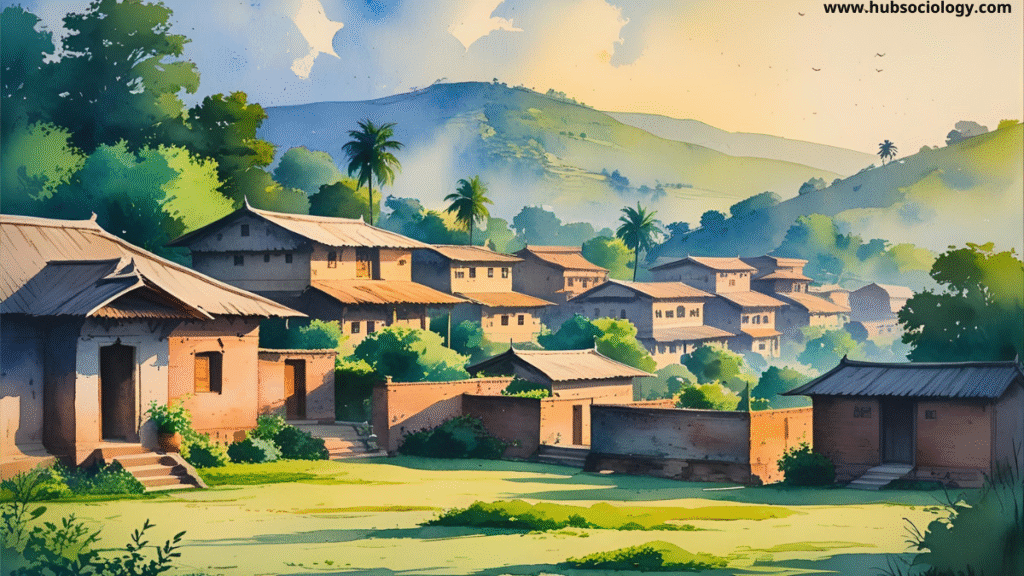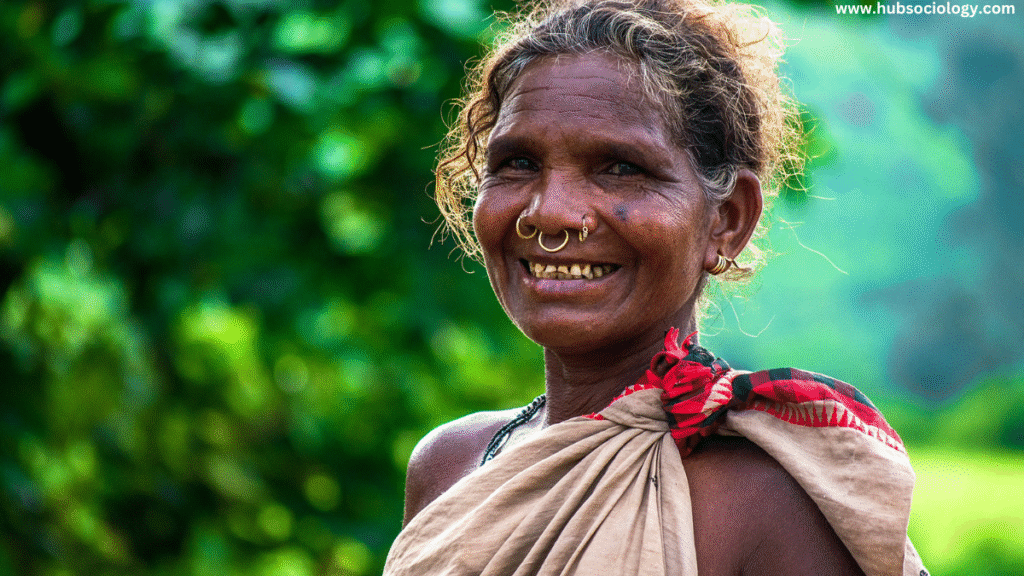Introduction
India, with its vast rural landscape, presents a complex interplay between relative isolation and social integration in its villages. While some villages remain relatively isolated due to geographical, economic, and cultural barriers, others are increasingly integrated into broader social, economic, and political networks. This comparative study explores the sociological implications of these two contrasting conditions, analyzing their impact on social cohesion, economic development, cultural preservation, and modernization.

Understanding Relative Isolation and Social Integration
Relative Isolation in Indian Villages
Relative isolation refers to the limited interaction between a village and external social, economic, and political systems. This isolation can be due to:
- Geographical Barriers – Remote locations, difficult terrain, and lack of transportation.
- Economic Constraints – Limited access to markets, banking, and employment opportunities.
- Cultural and Linguistic Differences – Strong adherence to traditional norms with minimal external influence.
- Technological Gaps – Poor internet connectivity and limited exposure to modern communication tools.
Examples of relatively isolated villages include tribal communities in Odisha, Jharkhand, and the Northeastern states, where traditional lifestyles persist with minimal external interference.
Social Integration in Indian Villages
Social integration refers to the process by which villages become interconnected with wider society through:
- Economic Linkages – Access to markets, government schemes, and employment opportunities.
- Technological Penetration – Mobile networks, internet access, and digital governance.
- Political Participation – Involvement in panchayati raj institutions and state policies.
- Cultural Exchange – Exposure to urban lifestyles, media, and education.
Villages in Punjab, Haryana, and parts of Kerala exhibit high social integration due to better infrastructure, education, and economic diversification.
Sociological Implications of Relative Isolation
1. Preservation of Traditional Social Structures
Isolated villages often maintain rigid social hierarchies, caste systems, and traditional governance (e.g., khap panchayats). While this preserves cultural identity, it can also perpetuate inequalities.
2. Limited Social Mobility
Due to restricted access to education and employment, social mobility remains low. Occupational patterns are often hereditary, reinforcing caste-based occupations.
3. Strong Community Bonds
Close-knit social networks foster collective identity and mutual support. However, this can also lead to resistance to change and exclusion of outsiders.
4. Gender Roles and Restrictions
Patriarchal norms tend to be more rigid in isolated villages, with limited opportunities for women in education and employment.

Sociological Implications of Social Integration
1. Erosion of Traditional Norms
Increased exposure to urban lifestyles leads to changing values, weakening caste rigidity, and altering family structures (e.g., nuclear families replacing joint families).
2. Economic Diversification and Migration
Integration facilitates non-agricultural employment, leading to rural-urban migration. While this improves incomes, it also causes demographic shifts, with youth moving to cities.
3. Political Awareness and Empowerment
Government schemes (e.g., MGNREGA, PMAY) and panchayati raj institutions empower villagers politically, increasing participation in governance.
4. Technological and Educational Advancements
Digital India initiatives and improved schooling enhance awareness, but also create a digital divide between tech-savvy youth and older generations.
Comparative Analysis: Benefits and Challenges
| Aspect | Relative Isolation | Social Integration |
|---|---|---|
| Social Cohesion | Strong, but exclusionary | Weaker, but more inclusive |
| Economic Stability | Subsistence-based, low risk | Market-dependent, higher vulnerability |
| Cultural Identity | Well-preserved | Rapidly changing |
| Gender Dynamics | Highly restrictive | Gradually liberalizing |
| Governance | Traditional authority (e.g., village elders) | Formal institutions (e.g., panchayats) |
Case Studies
1. Relative Isolation – Tribal Villages in Jharkhand
Many tribal villages in Jharkhand remain isolated due to forested terrain and limited infrastructure. They rely on subsistence farming and forest produce, with minimal state intervention. While this preserves indigenous culture, it also results in poor healthcare, education, and economic stagnation.

2. Social Integration – Villages in Punjab
Punjab’s villages, with high agricultural productivity and strong diaspora connections, are well-integrated. Farmers use modern techniques, and families often have members working abroad. However, this has also led to drug abuse and declining traditional values among youth.
Conclusion
The dichotomy between relative isolation and social integration in Indian villages presents both opportunities and challenges. While isolated villages maintain cultural authenticity, they often lag in development. Integrated villages experience modernization but face cultural erosion and economic vulnerabilities. A balanced approach—preserving cultural identity while promoting inclusive development—is essential for sustainable rural progress. Government policies should focus on infrastructure, education, and digital inclusion without disrupting traditional social fabrics.
Do you like this this Article ? You Can follow as on :-
Facebook – https://www.facebook.com/hubsociology
Whatsapp Channel – https://whatsapp.com/channel/0029Vb6D8vGKWEKpJpu5QP0O
Gmail – hubsociology@gmail.com
Topic Related Questions
5 Marks Questions (Short Answer Type)
- Define relative isolation and social integration in the context of Indian villages.
- List three factors contributing to the relative isolation of Indian villages.
- How does social integration impact caste dynamics in rural India?
- What role does technology play in the social integration of villages?
- Mention two positive and two negative effects of relative isolation on village communities.
- How does migration influence social integration in Indian villages?
- What are the key differences between traditional and modern governance in isolated vs. integrated villages?
- Explain how gender roles differ in relatively isolated and socially integrated villages.
- Name two government schemes that promote social integration in rural India.
- Why do some tribal villages in India remain relatively isolated?
10 Marks Questions (Descriptive Answer Type)
- Compare the economic structures of relatively isolated and socially integrated Indian villages.
- Discuss the impact of social integration on traditional cultural practices in rural India.
- Analyze how education acts as a bridge between isolation and integration in Indian villages.
- Examine the role of panchayati raj institutions in promoting social integration.
- How does relative isolation affect healthcare access in Indian villages?
- Discuss the challenges faced by youth in isolated villages compared to those in integrated villages.
- Explain the digital divide between isolated and integrated villages in India.
- How does globalization influence social integration in rural India?
- What are the effects of rural-urban migration on social structures in villages?
- Critically assess the role of media in breaking the isolation of Indian villages.
15 Marks Questions (Long Answer/Essay Type)
- “Relative isolation preserves culture but hinders development, while social integration brings progress but erodes traditions.” Critically evaluate this statement with reference to Indian villages.
- Compare and contrast the social, economic, and political life of a relatively isolated village with that of a socially integrated village in India.
- How do caste and gender dynamics differ in isolated and integrated villages? Discuss with sociological perspectives.
- “The government’s push for digital India has both integrated and marginalized rural communities.” Discuss.
- Examine the impact of globalization on relatively isolated tribal villages versus developed agrarian villages in India.
- What are the major challenges in transforming an isolated village into an integrated one? Suggest policy measures.
- How does social integration affect the mental health and social well-being of villagers?
- Discuss the role of NGOs and civil society in bridging the gap between isolated and integrated villages.
- “Economic development in rural India cannot succeed without social integration.” Do you agree? Justify your answer.
- Analyze the effects of infrastructure development (roads, electricity, internet) on reducing relative isolation in Indian villages.
